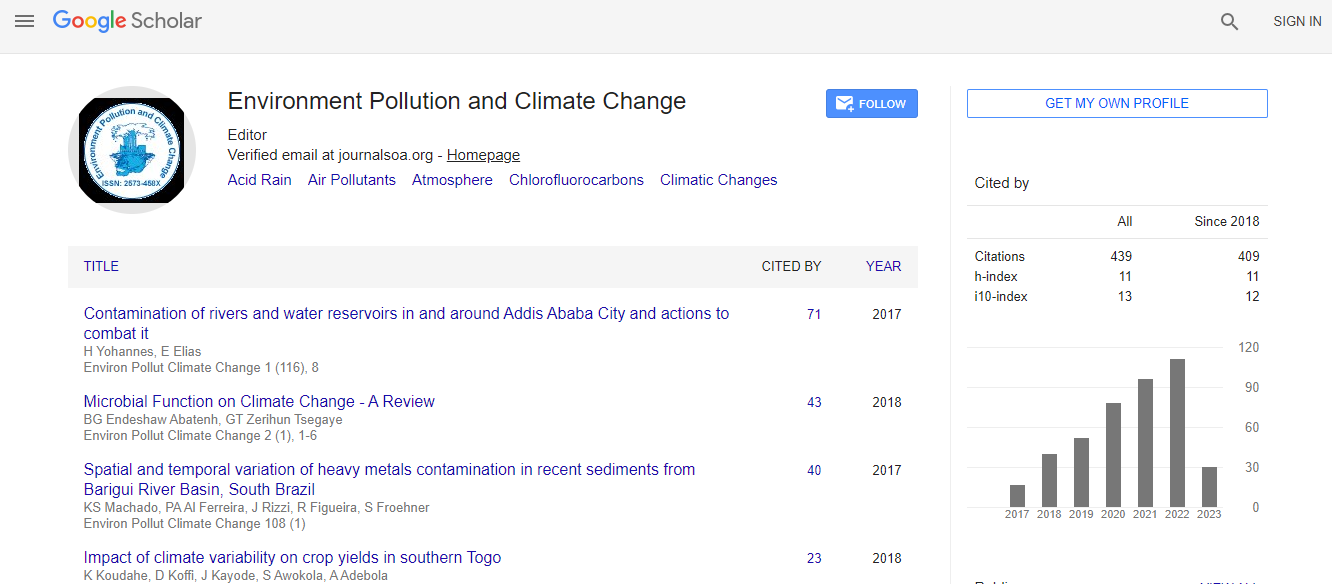Our Group organises 3000+ Global Conferenceseries Events every year across USA, Europe & Asia with support from 1000 more scientific Societies and Publishes 700+ Open Access Journals which contains over 50000 eminent personalities, reputed scientists as editorial board members.
Open Access Journals gaining more Readers and Citations
700 Journals and 15,000,000 Readers Each Journal is getting 25,000+ Readers
Google Scholar citation report
Citations : 672
Environment Pollution and Climate Change received 672 citations as per Google Scholar report
Environment Pollution and Climate Change peer review process verified at publons
Indexed In
- Google Scholar
- Publons
- Euro Pub
- ICMJE
Useful Links
Recommended Journals
Share This Page
Agricultural pesticide induced bone marrow aplastic anaemia and the hedgehog signaling scenario
Joint Event on 5th World Conference on Climate Change & 16th Annual Meeting on Environmental Toxicology and Biological Systems
Sujata Law
Calcutta School of Tropical Medicine, India
Keynote: Environ Pollut Climate Change
Abstract
Multiple health hazards and fatalities from the widespread use of pesticides have been reported by the WHO. Developing countries primarily dependent on agriculture for their economies such as India, Bangladesh and Thailand are especially reliant on these chemicals. Consequentially, public health has been on a decline and there is a lacuna of knowledge about the effect of pesticide exposure on bone marrow haematopoietic system. The on-field scenario was mimicked in murine model to explore the consequences of chronic pesticide exposure. In the present work, we have developed an agricultural pesticide formulation (fungicide, organophosphate and pyrethroid) induced bone marrow aplasia mouse model to recapitulate the human aplastic anemia like condition in the laboratory to study the aplastic hematopoietic microenvironment in the light of Hh-GLI signaling pathway. Our study has unfolded the fact that chronic pesticide exposure caused downregulation of intrasignaling feedback of PATCH1 and GLI1 by inhibiting the SMO internalization and upregulating downstream negative regulators SU(FU), PKC-δ and βTrCP. Upregulation of negative regulators not only hampers the execution of the hedgehog signaling but also cripples the autocrine-paracrine crosstalk in between bone marrow primitive compartment and stromal compartment. Simultaneously, individual pesticide versus hedgehog signaling study revealed that hexaconazole disrupted hematopoietic hedgehog signaling activation by inhibiting SMO and facilitating PKC-δ expression. Contrarily, chloropyrifos increased the cytoplasmic sequestration and degradation of GLI1 by upregulating SU(FU) and βTrCP sequentially. Whereas, cypermethrin mediated antagonization of the hedgehog signaling was circumvented by non-canonical activation of GLI1. However, such marrow degenerative condition can be compensated by the recombinant sonic hedgehog. We can conclude that pesticide exposure induced bone marrow aplasia is the direct manifestation of downregulated hedgehog signaling in the bone marrow microenvironment.Biography
Sujata Law did her PhD in Stem Cell Biology from the University of Calcutta and Postdoctoral studies in the field of Signal Transduction from Bose Institute, Kolkata. She is in the Faculty of Stem Cell Biology in the Department of Biochemistry & Medical Biotechnology at Calcutta School of Tropical Medicine a hundred years old government institution Kolkata, India. She has teaching experience in the field of Physiology, Signal Transduction, Cell Culture and Tissue Engineering, Haematology, Stem Cells, Cellular Immunology, Cell Biology, and aspects of Molecular Biology and Biotechnology at postgraduate level and received many research projects as Principal Investigator from various government scientific organizations like CSIR, ICMR, DST, DBT, etc. She has 57 publications in various international and national reputed journals and has guided many PhD students and delivered invited talks in India and abroad.
E-mail: msuj2002@yahoo.co.in

 Spanish
Spanish  Chinese
Chinese  Russian
Russian  German
German  French
French  Japanese
Japanese  Portuguese
Portuguese  Hindi
Hindi 
